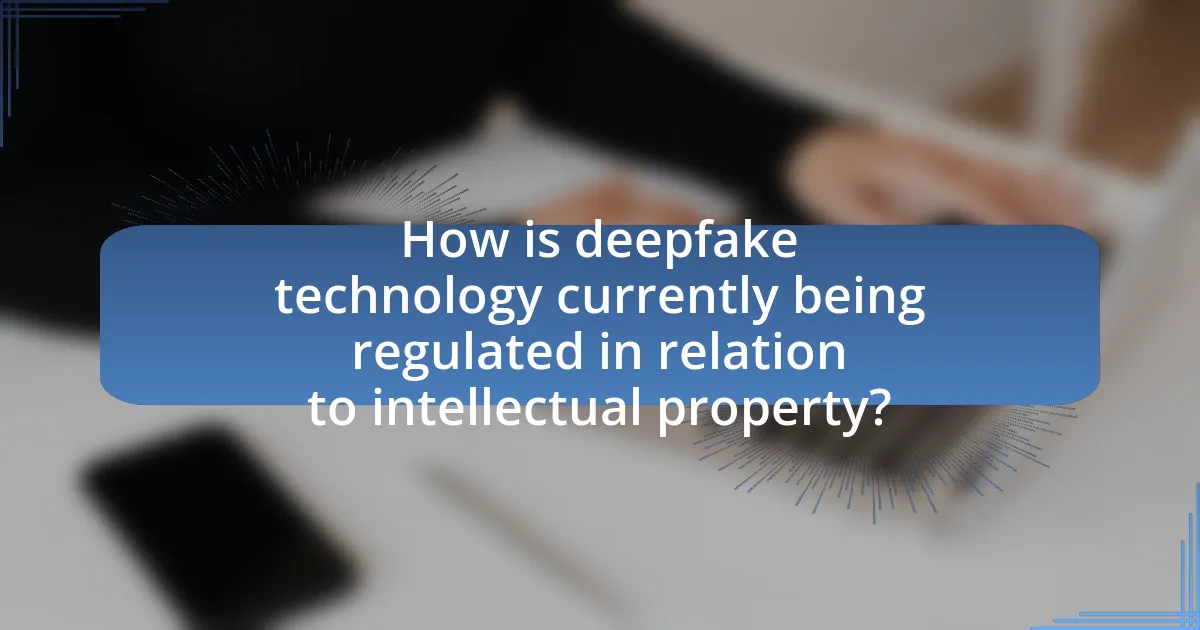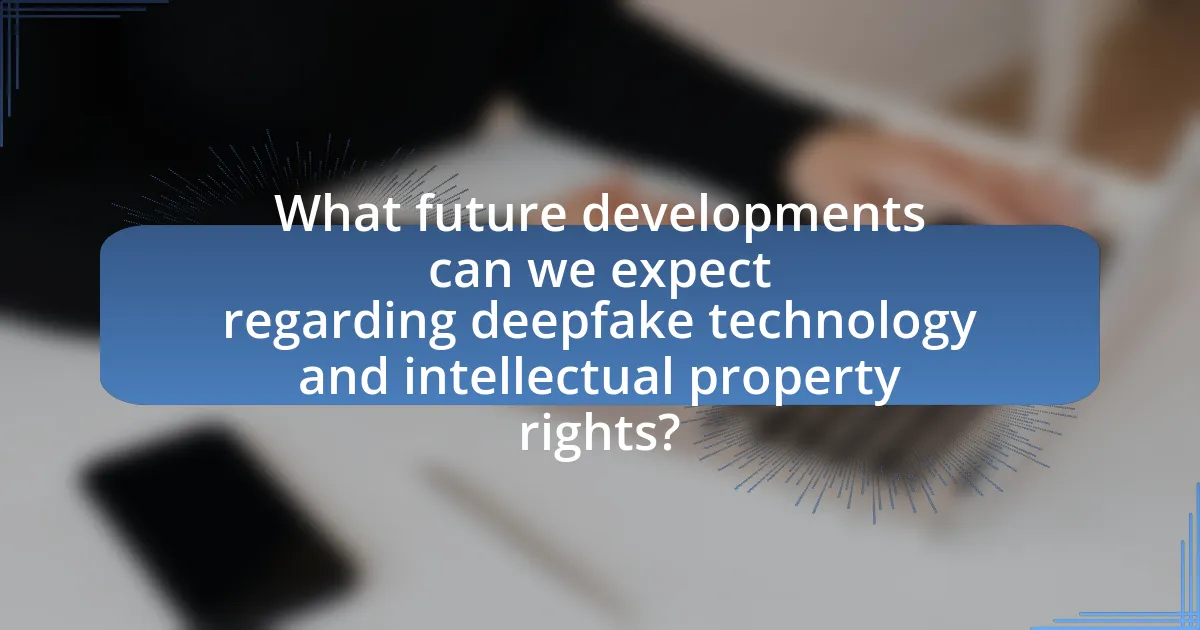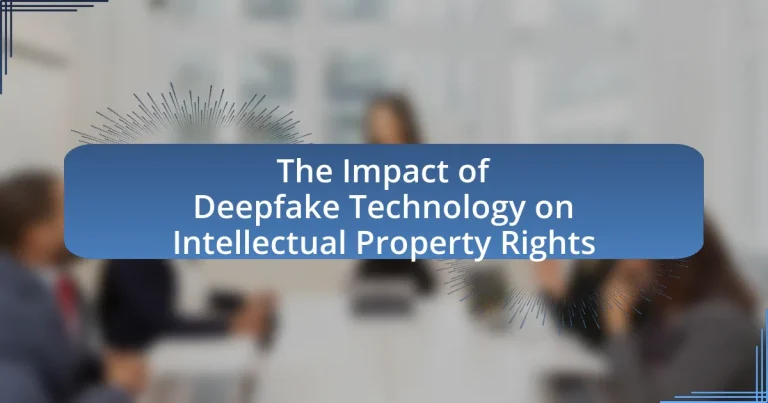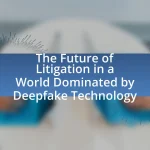Deepfake technology poses significant challenges to intellectual property rights by enabling unauthorized use and manipulation of copyrighted materials, including likenesses and brand identities. This article examines how deepfake technology functions, its implications for copyright and trademark protections, and the legal frameworks currently in place to address these challenges. It highlights the risks posed by deepfakes, including potential infringement and consumer confusion, and discusses the effectiveness of existing regulations. Additionally, the article explores future developments in legal frameworks and best practices for protecting intellectual property against deepfake misuse.

What is the Impact of Deepfake Technology on Intellectual Property Rights?
Deepfake technology significantly challenges intellectual property rights by enabling the unauthorized use and manipulation of copyrighted materials. This technology allows individuals to create realistic audio and visual content that can impersonate others, leading to potential violations of rights associated with likeness, voice, and brand identity. For instance, a study by the European Union Intellectual Property Office in 2020 highlighted that deepfakes could undermine the integrity of original works, as they can be used to create misleading representations that infringe on the original creator’s rights. Additionally, the legal frameworks surrounding intellectual property are often ill-equipped to address the rapid advancements in deepfake technology, creating a gap in protection for creators and rights holders.
How does deepfake technology function in relation to intellectual property?
Deepfake technology functions in relation to intellectual property by enabling the creation of realistic synthetic media that can infringe on the rights of original content creators. This technology utilizes artificial intelligence to manipulate existing images, videos, or audio, often without the consent of the individuals depicted, thereby raising significant legal and ethical concerns regarding copyright and trademark protections. For instance, deepfakes can be used to replicate a celebrity’s likeness in unauthorized advertisements, violating their right of publicity, which protects against unauthorized commercial use of one’s identity. Additionally, the unauthorized use of copyrighted material in the creation of deepfakes can lead to copyright infringement claims, as the original creators retain exclusive rights to their works.
What are the key components of deepfake technology?
The key components of deepfake technology include machine learning algorithms, particularly generative adversarial networks (GANs), and large datasets of images and videos. Machine learning algorithms enable the creation of realistic synthetic media by training on existing data, while GANs consist of two neural networks that work against each other to improve the quality of the generated content. Large datasets provide the necessary input for these algorithms, allowing them to learn facial features, expressions, and movements, which are crucial for producing convincing deepfakes.
How do these components interact with intellectual property laws?
Deepfake technology interacts with intellectual property laws by challenging existing frameworks for copyright, trademark, and privacy rights. The creation of deepfakes often involves the unauthorized use of copyrighted materials, such as images or videos, which can infringe on the rights of the original creators. Additionally, deepfakes can mislead consumers by impersonating brands or individuals, potentially violating trademark laws. Courts have begun to address these issues, as seen in cases where deepfakes were used to create misleading content, prompting legal scrutiny under both copyright and trademark statutes. This evolving landscape necessitates updates to intellectual property laws to adequately protect rights holders against misuse of their works through deepfake technology.
What are the potential risks posed by deepfake technology to intellectual property rights?
Deepfake technology poses significant risks to intellectual property rights by enabling the unauthorized use and manipulation of copyrighted materials. This technology allows individuals to create realistic but fake audio and video content that can misrepresent the original creator’s work, leading to potential infringement and dilution of brand identity. For instance, deepfakes can be used to create counterfeit advertisements or misleading endorsements, which can confuse consumers and harm the reputation of the original brand. Additionally, the ease of creating and distributing deepfakes increases the likelihood of copyright violations, as creators may not seek permission to use protected content. The legal framework surrounding intellectual property is often ill-equipped to address these challenges, making it difficult for rights holders to protect their work effectively.
How can deepfakes infringe on copyright protections?
Deepfakes can infringe on copyright protections by using copyrighted images, videos, or audio without permission to create misleading or unauthorized content. This unauthorized use violates the rights of the original creators, as it can lead to the distribution of altered works that misrepresent the original intent or message. For instance, a deepfake that uses an actor’s likeness without consent can undermine the actor’s rights to control the use of their image, which is protected under copyright law. Additionally, the creation and distribution of deepfakes can result in economic harm to the copyright holder, as it may dilute the market for the original work or mislead consumers, thereby infringing on the exclusive rights granted to creators under copyright statutes.
What are the implications for trademark rights with the use of deepfakes?
The use of deepfakes poses significant implications for trademark rights by potentially leading to unauthorized use of brand images and logos, which can result in consumer confusion and dilution of brand identity. Deepfakes can create realistic representations of trademarked entities without consent, allowing for misleading advertisements or endorsements that do not reflect the actual views or affiliations of the trademark owner. This unauthorized use can infringe upon the trademark rights established under the Lanham Act, which protects against false advertising and trademark dilution. Legal cases, such as the 2019 ruling in the case of “Gordon v. Google,” illustrate how courts are beginning to address the complexities of digital representations and their impact on trademark rights, emphasizing the need for updated legal frameworks to protect brands in the age of deepfake technology.

How is deepfake technology currently being regulated in relation to intellectual property?
Deepfake technology is currently regulated in relation to intellectual property through a combination of existing copyright laws, state-level legislation, and proposed federal regulations. Copyright laws protect original works, which can include images and videos manipulated by deepfake technology, thereby granting creators rights over their content. For instance, the U.S. Copyright Office has indicated that deepfakes may infringe on the rights of original content creators if their likeness or voice is used without permission. Additionally, several states have enacted laws specifically targeting the malicious use of deepfakes, such as California’s law against the use of deepfakes for harassment or fraud, which further emphasizes the need for protection of intellectual property rights. Proposed federal legislation, like the Malicious Deep Fake Prohibition Act, aims to address the broader implications of deepfake technology on intellectual property and personal rights, indicating a growing recognition of the need for regulatory frameworks in this area.
What existing laws address the challenges posed by deepfake technology?
Existing laws addressing the challenges posed by deepfake technology include the Computer Fraud and Abuse Act (CFAA), which can be applied to unauthorized use of deepfake technology for fraud, and various state laws that specifically target deepfakes, such as California’s AB 730, which prohibits the use of deepfakes to harm or defraud others. Additionally, intellectual property laws, including copyright and trademark protections, can be invoked when deepfakes infringe on the rights of creators or brands. These laws provide a legal framework to combat the misuse of deepfake technology and protect individuals and entities from potential harm.
How effective are current regulations in protecting intellectual property rights?
Current regulations are moderately effective in protecting intellectual property rights, but they face significant challenges due to technological advancements like deepfake technology. Existing laws, such as the Digital Millennium Copyright Act (DMCA) and the Copyright Act, provide frameworks for addressing copyright infringement; however, they often lag behind the rapid evolution of digital content creation and manipulation. For instance, a report by the U.S. Copyright Office in 2022 highlighted that while copyright law can address some aspects of deepfake technology, it does not adequately cover the nuances of unauthorized use of likenesses or the potential for misleading representations. This gap indicates that while regulations exist, their effectiveness is compromised by the need for updates and adaptations to new technologies.
What legal precedents exist regarding deepfakes and intellectual property?
Legal precedents regarding deepfakes and intellectual property are still developing, with few established cases directly addressing the issue. One notable case is “Gordon v. Google LLC,” where the court ruled that the unauthorized use of a celebrity’s likeness in a deepfake video could violate the right of publicity, which is a form of intellectual property. This case highlights the potential for deepfakes to infringe on an individual’s rights to control the commercial use of their identity. Additionally, the “California Consumer Privacy Act” and various state laws are beginning to address the implications of deepfakes on privacy and intellectual property, indicating a growing legal framework around these technologies.
What are the challenges in enforcing intellectual property rights against deepfakes?
Enforcing intellectual property rights against deepfakes presents significant challenges due to the technology’s ability to create realistic and deceptive content that often falls into legal gray areas. One major challenge is the difficulty in identifying the original creator of the content, as deepfakes can manipulate existing media without clear attribution, complicating the enforcement of copyright laws. Additionally, the rapid evolution of deepfake technology outpaces existing legal frameworks, which are often not equipped to address the nuances of digital manipulation and its implications for ownership. Furthermore, the anonymity of the internet allows creators of deepfakes to evade accountability, making it hard for rights holders to pursue legal action. These factors collectively hinder effective enforcement of intellectual property rights in the context of deepfakes.
How do jurisdictional issues complicate enforcement?
Jurisdictional issues complicate enforcement by creating legal ambiguities regarding which laws apply and which courts have authority over a case. In the context of deepfake technology and intellectual property rights, these complications arise because deepfakes can be created and distributed across multiple jurisdictions, often making it difficult to determine where an infringement occurred. For instance, if a deepfake violates copyright in one country but is hosted on a server in another, conflicting laws may hinder effective legal action. Additionally, varying standards of proof and enforcement mechanisms across jurisdictions can lead to inconsistent outcomes, further complicating the ability to protect intellectual property rights effectively.
What role do digital forensics play in identifying deepfake infringements?
Digital forensics play a crucial role in identifying deepfake infringements by employing advanced analytical techniques to detect manipulated media. These techniques include analyzing metadata, examining pixel inconsistencies, and utilizing machine learning algorithms to differentiate between authentic and altered content. For instance, studies have shown that digital forensics can identify deepfakes with over 90% accuracy by scrutinizing the visual and audio anomalies that often accompany synthetic media. This capability is essential for protecting intellectual property rights, as it enables stakeholders to take legal action against unauthorized use of their likeness or content.

What future developments can we expect regarding deepfake technology and intellectual property rights?
Future developments in deepfake technology will likely lead to more stringent intellectual property rights regulations. As deepfake technology advances, the potential for misuse in creating unauthorized content increases, prompting lawmakers to address these challenges. For instance, the rise of deepfake videos has already led to discussions around the need for clearer legal frameworks that define ownership and consent regarding digital likenesses. Countries like the United States and members of the European Union are exploring legislation that could establish guidelines for the ethical use of deepfake technology, ensuring that creators maintain control over their intellectual property. This trend is supported by the increasing number of legal cases involving deepfakes, which highlight the urgent need for protective measures in intellectual property law.
How might advancements in deepfake technology affect intellectual property laws?
Advancements in deepfake technology could significantly challenge existing intellectual property laws by complicating the attribution of authorship and ownership of digital content. As deepfakes become more sophisticated, they can create realistic representations of individuals without their consent, leading to potential violations of rights associated with personal likeness and brand identity. For instance, the unauthorized use of a celebrity’s likeness in a deepfake video could infringe on their right of publicity, which protects against unauthorized commercial use of one’s identity. Furthermore, the creation of deepfakes may blur the lines of copyright, as it raises questions about whether the original content creator retains rights over altered versions of their work. This evolving landscape necessitates a reevaluation of intellectual property frameworks to address the unique challenges posed by deepfake technology, as highlighted by legal scholars who argue for updated regulations that specifically account for digital manipulation and its implications on ownership rights.
What new legal frameworks could emerge to address these challenges?
New legal frameworks that could emerge to address the challenges posed by deepfake technology on intellectual property rights include specific regulations for digital content authenticity and liability standards for creators and distributors of deepfake media. These frameworks may establish clear definitions of deepfakes, outline the rights of individuals whose likenesses are used without consent, and impose penalties for misuse. For instance, jurisdictions may adopt laws similar to California’s AB 730, which addresses the unauthorized use of deepfakes in political campaigns, thereby providing a model for broader applications in intellectual property contexts. Such regulations would aim to protect creators’ rights while ensuring accountability for the misuse of technology that can infringe upon personal and intellectual property rights.
How can stakeholders prepare for future implications of deepfake technology?
Stakeholders can prepare for future implications of deepfake technology by implementing robust verification systems and developing comprehensive legal frameworks. Verification systems, such as digital watermarks and blockchain technology, can help authenticate content and identify deepfakes, as evidenced by the increasing use of these technologies in media organizations to combat misinformation. Additionally, stakeholders should advocate for updated intellectual property laws that address the unique challenges posed by deepfakes, ensuring that creators’ rights are protected and that there are clear guidelines for accountability. Research from the Brookings Institution highlights the need for proactive measures in policy-making to mitigate the risks associated with deepfake technology, emphasizing the importance of collaboration among technology developers, legal experts, and policymakers.
What best practices can individuals and organizations adopt to protect their intellectual property from deepfakes?
Individuals and organizations can protect their intellectual property from deepfakes by implementing robust digital watermarking and authentication technologies. Digital watermarking embeds unique identifiers within content, making it easier to trace and verify authenticity, while authentication technologies can confirm the legitimacy of the source. For instance, the use of blockchain technology for content verification has gained traction, as it provides an immutable record of ownership and modifications, thereby deterring unauthorized alterations. Additionally, educating employees and stakeholders about the risks associated with deepfakes and promoting vigilance in content verification can further safeguard intellectual property. According to a report by the European Union Intellectual Property Office, awareness and proactive measures are essential in combating the misuse of digital content, highlighting the importance of these best practices.
How can awareness and education mitigate risks associated with deepfake technology?
Awareness and education can significantly mitigate risks associated with deepfake technology by equipping individuals with the knowledge to identify and critically assess manipulated media. Educating the public about the existence and capabilities of deepfakes fosters skepticism towards unverified content, reducing the likelihood of misinformation spread. For instance, a study by the University of California, Berkeley, found that individuals who received training on recognizing deepfakes were 80% more likely to identify them correctly compared to those without such training. This highlights that informed individuals are less susceptible to deception, thereby protecting intellectual property rights from misuse and unauthorized exploitation.
What tools and technologies are available to detect and combat deepfakes?
Various tools and technologies are available to detect and combat deepfakes, including machine learning algorithms, digital forensics techniques, and specialized software. Machine learning algorithms, such as convolutional neural networks, analyze video and audio data for inconsistencies that indicate manipulation. Digital forensics techniques involve examining metadata and pixel-level anomalies to identify alterations. Specialized software like Deepware Scanner and Sensity AI provides real-time detection capabilities by leveraging large datasets of known deepfakes to improve accuracy. These technologies are essential in addressing the challenges posed by deepfake technology, particularly in the context of intellectual property rights, where authenticity is crucial.


